horn PONTIAC BONNEVILLE 1993 Owners Manual
[x] Cancel search | Manufacturer: PONTIAC, Model Year: 1993, Model line: BONNEVILLE, Model: PONTIAC BONNEVILLE 1993Pages: 322, PDF Size: 16.31 MB
Page 9 of 322
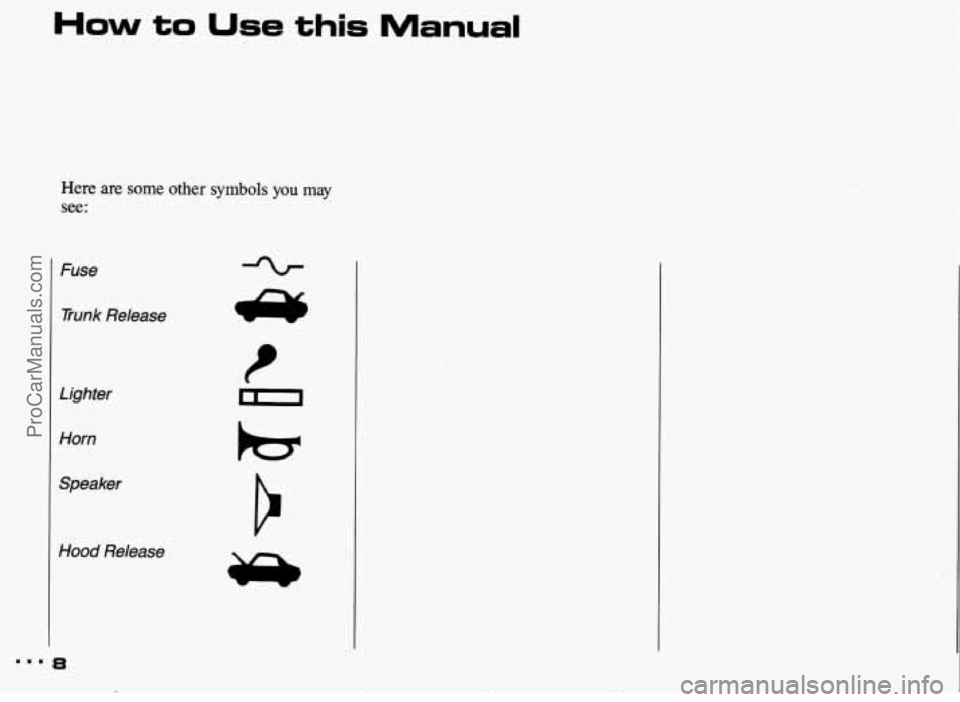
How to Use this Manual
Here are some other symbols you may
see:
Fuse Trunk Release
Lighter
Horn
Speaker
Hood Release
mm. 8
t r Y ProCarManuals.com
Page 55 of 322
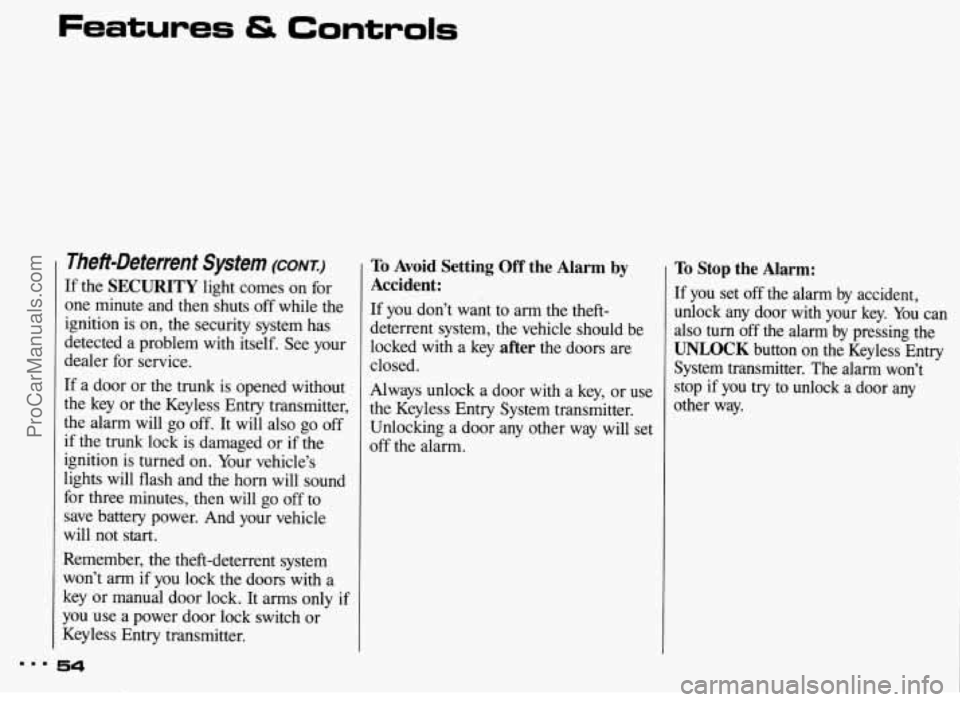
Features & Controls
Theft-Deterrent System (CONI:)
If the SECURITY light comes on for
one minute and then shuts off while the
ignition is on, the security system has
detected a problem with itself. See your
dealer for service.
If a door or the trunk is opened without
the key or the Keyless Entry transmitter,
the alarm will go off.
It will also go off
if the trunk lock is damaged or if the
ignition
is turned on. Your vehicle’s
lights will flash and the horn will sound
for three minutes, then will go
off to
save battery power. And your vehicle
will not
start.
Remember, the theft-deterrent system
won’t arm if you lock the doors with a
key or manual door lock.
It arms only if
you use a power door lock switch or
Keyless Entry transmitter.
To Avoid Setting Off the Alarm by
Accident:
If you don’t want to arm the theft-
deterrent system, the vehicle should be
locked with a key
after the doors are
closed.
Always unlock a door with a key, or use
the Keyless Entry System transmitter.
Unlocking a door any other way will set
off
the alarm.
To Stop the Alarm:
If you set off the alarm by accident,
unlock any door with your key.
You can
also turn off the alarm by pressing the
UNLOCK button on the Keyless Entry
System transmitter. The
alarm won’t
stop if you try to unlock
a door any
other way.
..I 54
ProCarManuals.com
Page 56 of 322
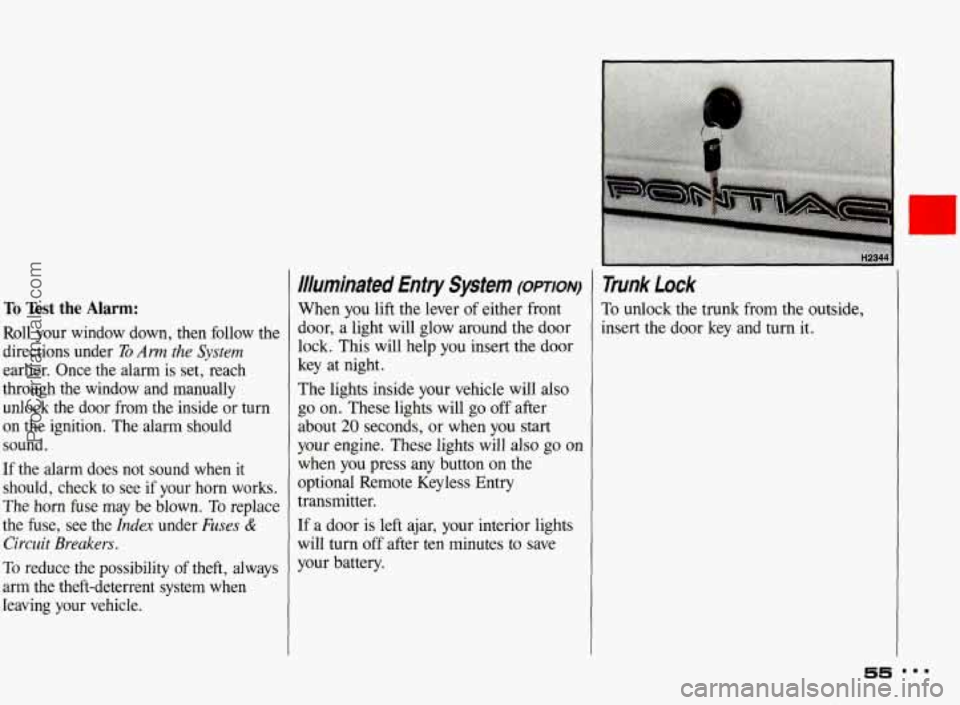
To Test the Almn:
Roll pur window down, then follow the
directions under
221 Am the System
earlier. Once tbe alarm is set, reach
through the
window and manually
unlock the door from the inside or turn
on the ignition. The alarm should
sound.
If the dam does not sound when it
should, check to see if your horn works.
The
horn fuse may be Mown. Ta replace
the
fuse, see the Index under FEares &
Circuit Breakers.
To reduce the possibility of theft, always
arm the theft-deterrent system when
leaving your vehicle.
tIEumhated Enfry Spkm ~~KNW)
When you lift the lever of either front
door, a light will glow
around the door
lock. This
will help you insert the door
key at night.
The lights inside your vehicle will also
go on. These lights will go off after
about
20 seconds, or when you start
your engine. These lights will also go on
when you press my button on the
optional Remote Keyless
Entry
transmitter.
If a door is left ajar, your interior lights
will
turn off after ten minutes to save
your battery.
H2344 I
Trunk hk
Ta unlock the trunk from the outside,
insert the door key and turn it.
55
ProCarManuals.com
Page 73 of 322
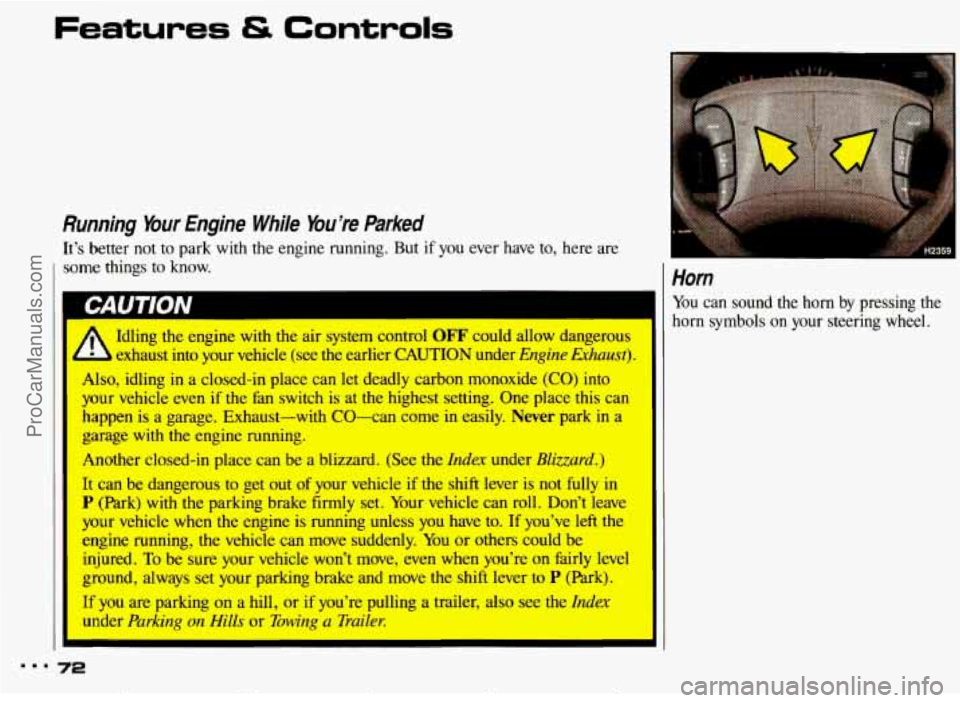
Features & Controls
Running Your Engine While You’re Parked
It’s better not to park with the engine running. But if you ever have to, here are
I some things to know.
II Idling the engine with the air system control OFF could allow dangerous
xhaust
into your vehicle (see the earlier CAUTION under Engine Exhaust). ‘
so, idling in a closed-in place can let deadly carbon monoxide (CO) into
your vehicle even
if the fan switch is at the highest setting. One place this can
happen is a garage. Exhaust-with CO-can come
in easily. Never park in a
garage
with the engine running.
Another closed-in place can be a blizzard. (See
the Index under Bliaard.)
It can be dangerous to get out of your vehicle if the shift lever is not fully in
P (Park) with the parking brake firmly set. Your vehicle can roll. Don’t leave
your vehicle when the engine is running unless you have to. If you’ve
left the
engine running, the vehicle can move suddenly. You or others could be
injured.
To be sure your vehicle won’t move, even when you’re on fairly level\
ground, always set your parking brake and move
the shift lever to P (Park).
If you are parking on a hill, or if you’re pulling a trailer, also see the Zndex
under Parking on Hills or Towing a Truik
rn.1 72
Horn
You can sound the horn by pressing the
horn
symbols on your steering wheel,
ProCarManuals.com
Page 96 of 322
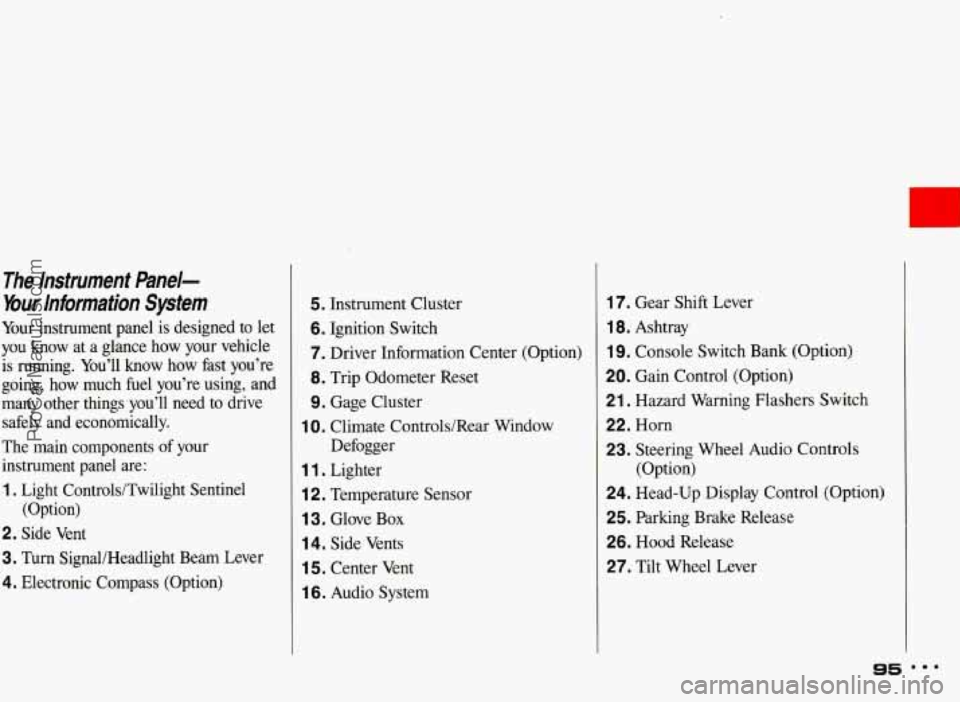
r
The Instrument &ne/-
bur Information System
Your instrument panel is designed to let
you know at a glance how your vehicle
is running. You’ll know how fast you’re
going, how much fuel you’re using, and
many other things you’ll need to drive
safely and economically.
The main components of your
instrument panel are:
1. Light Controls/Twilight Sentinel
2. Side Vent
3. Turn SignaUHeadlight Beam Lever
4. Electronic Compass (Option) (Option)
5. Instrument Cluster
6. Ignition Switch
7. Driver Information Center
(Option)
8. Trip Odometer Reset
9. Gage Cluster
Defogger
1 0. Climate Controls/Rear Window
1 1 . Lighter
i 2. Temperature Sensor
1 3. Glove Box
14. Side Vents
1 5. Center Vent
1 6. Audio System
17. Gear Shift Lever
1 8. Ashtray
19. Console Switch Bank (Option)
20. Gain Control (Option)
21. Hazard Warning Flashers Switch
22. Horn
23. Steering Wheel Audio Controls
24. Head-Up Display Control (Option)
25. Parking Brake Release
26. Hood Release
27. Tilt Wheel Lever (Option)
95 mmm
ProCarManuals.com
Page 164 of 322
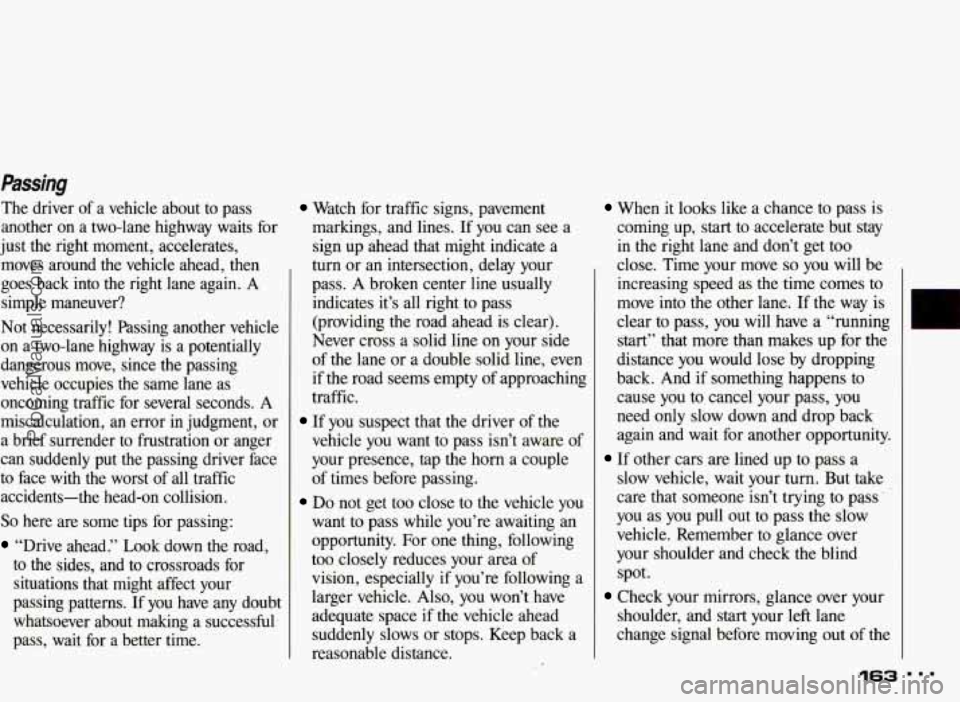
Passing
The driver of a vehicle about to pass
another on a two-lane highway waits for
just the right moment, accelerates,
moves around
the vehicle ahead, then
goes back into the right lane again.
A
simple maneuver?
Not necessarily! Passing another vehicle
on a two-lane highway is a potentially
dangerous move, since the passing
vehicle occupies the same lane as
oncoming traffic for several seconds.
A
miscalculation, an error in judgment, or
a brief surrender to frustration or anger
can suddenly put the passing driver face
to face with the worst of all traffic
accidents-the head-on collision.
So here are some tips for passing:
“Drive ahead.” Look down the road,
to the sides, and to crossroads for
situations that might affect your
passing patterns. If you have any doubt
whatsoever about making a successful.
pass, wait for a better time.
Watch for traffic signs, pavement
markings, and lines.
If you can see a
sign up ahead that might indicate a
turn or an intersection, delay your
pass. A broken center line usually
indicates it’s all right to pass
(providing the road ahead is clear).
Never cross a solid line
on your side
of the lane or a double solid line, even
if the road seems empty of approaching
traffic.
vehicle you want
to pass isn’t aware of
your presence, tap the horn a couple
of times before passing.
Do not get too close to the vehicle you
want to pass while you’re awaiting an
opportunity. For one thing, following
too closely reduces your area of
vision, especially if you’re following
a
larger vehicle. Also, you won’t have
adequate space
if the vehicle ahead
suddenly slows or stops. Keep back a
reasonable distance.
If you suspect that the driver of the
When it looks like a chance to pass is
coming up, start to accelerate but stay
in the right lane and don’t get too
close. Time your move
so you will be
increasing speed as the time comes to
move into the other lane. If the way is
clear to pass, you will have a “running
start’’ that more than makes up for the
distance you would lose by dropping
back. And if something happens to
cause you to cancel your pass,
you
need only slow down and drop back
again and wait for another opportunity.
slow vehicle, wait your turn. But take
care that someone isn’t trying to pqss
you as
you pull out to pass the slow
vehicle. Remember to glance over
your shoulder and check the blind
spot.
Check your mirrors, glance over your
shoulder, and start your left lane
change signal before moving out
of the
If other cars are lined up to pass a
L
163
ProCarManuals.com
Page 172 of 322
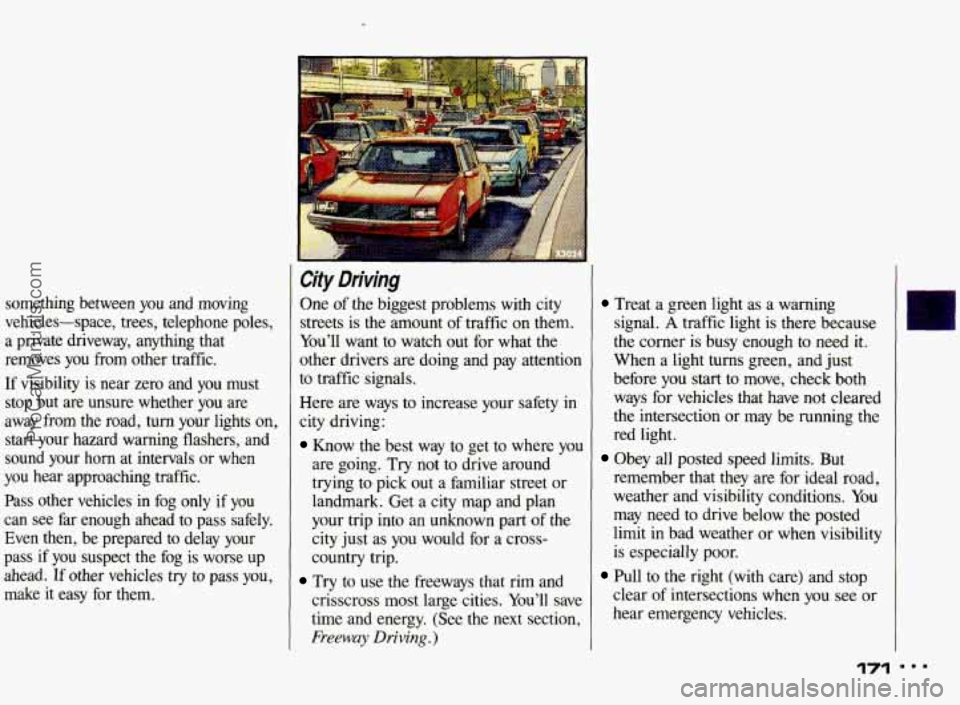
something between you and moving
vehicles-space, trees, telephone poles,
a private driveway, anything that
removes
you from other traffic.
If visibility is near zero and you must
stop but
are unsure whether you are
away from the road,
turn your lights on,
start your hazard warning flashers, and
sound your
horn at intervals or when
you hear approaching traffic.
Pass other vehicles in fog only if you
can see far enough ahead to pass safely. Even then, be prepared to delay your
pass if you suspect the fog
is worse up
ahead.
If other vehicles try to pass you,
make it easy for them.
City Driving
One of the biggest problems with city
streets
is the amount of traffic on them.
You’ll want to watch out for what the
other drivers are doing and
pay attention
to traffic signals.
Here are ways
to increase your safety in
city driving:
Know the best way to get to where you
are going. Try not to drive around
trying to pick out a familiar street or
landmark. Get a city map and plan
your trip into an unknown part
of the
city just as you would for a cross-
country trip.
Try to use the freeways that rim and
crisscross
most large cities. You’ll save
time and energy. (See the next section,
Freeway Driving.)
Treat a green light as a warning
signal.
A traffic light is there because
the corner is busy enough
to need it.
When a light turns green, and just
before you
start to move, check both
ways for vehicles that have not cleared
the intersection or may be running the
red light.
remember that they are for ideal road,
weather and visibility conditions. You
may need to drive below the
posted
limit in bad weather or when visibility
is especially poor.
clear of intersections when you see or
hear emergency vehicles.
Obey all posted speed limits. But
Pull to the right (with care) and stop
171
ProCarManuals.com
Page 269 of 322
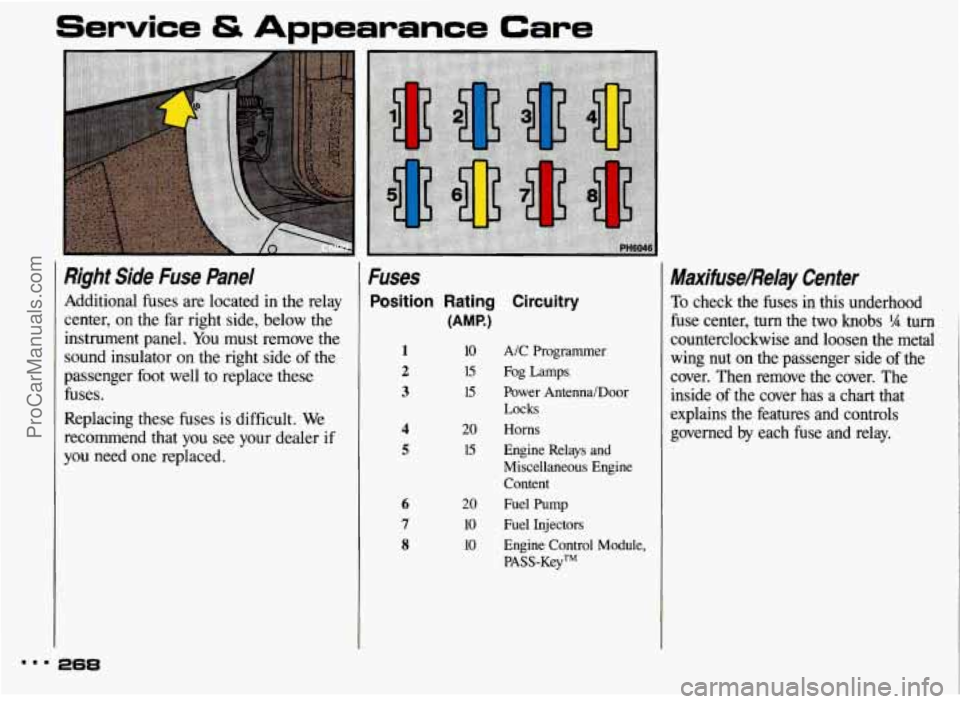
Service & A .ante Care
Righf Side Fuse Panel Fuses
Additional fuses are located in the relay
(AMP.) center, on the far right side, below the
Position Rating Circuitry
instrument panel. %u must remove the
sound insulator
on the right side of the
passenger
foot well to replace these
fuses.
Replacing these fuses is difficult. We
recommend that you see your dealer if
you need one replaced.
1
2
3
4
5
6
7
8
10
15
15
20
15
20
10
10
A/C Programmer
Fog Lamps
Power Antenna/Door Locks
Horns
Engine Relays and
Miscellaneous Engine
Content
Fuel Pump
Fuel Injectors
Engine Control Module, PASS-KeyTM
Maxifuse/Relay Center
To check the fuses in this underhood
fuse center, turn the two
knobs % turn
counterclockwise and loosen
the metal
wing nut on the passenger side
of the
cover. Then remove the cover. The
inside of the cover has a chart that
explains the features and controls
governed by each fuse and relay.
am. 268
ProCarManuals.com
Page 316 of 322
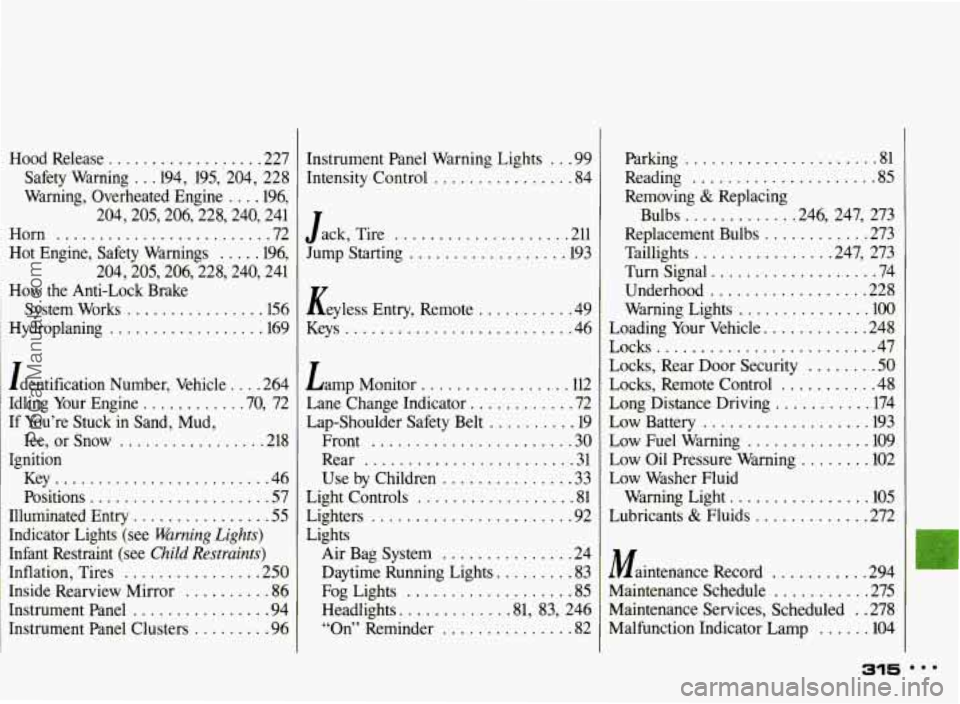
Hood Release .................. 227
Safety Warning
.. .194. 195. ’ 204. 228
Warning. Overheated Engine
... .196.
204.205.206.228.240. 241
Horn
......................... 72
Hot Engine. Safety Warnings
.... .196.
204.205.206.228.240. 241
How the Anti-Lock Brake
System Works
............... -156
Hydroplaning
.................. 169
Identification Number. Vehicle
.... 264
If You’re Stuck in Sand. Mud.
Ignition Idling Your Engine
........... .70.
72
Ice. or Snow
................. 218
Key
......................... 46
Positions
..................... 57
Illuminated Entry
................ 55
Inflation. Tires
................ 250
Indicator Lights (see
Warning
Lights)
Infant Restraint (see Child Restraints)
Inside Rearview Mirror .......... 86
Instrument Panel
................ 94
Instrument Panel Clusters
......... 96
Instrument Panel Warning Lights ... 99
Intensity Control
................ 84
.................... J ack. Tire 211
Jump Starting
.................. 193
Keyless Entry. Remote
........... 49
Keys
.......................... 46
Lamp Monitor
................. 112
Lane Change Indicator
............ 72
Lap-Shoulder Safety Belt
.......... 19
Front
....................... 30
Rear
........................ 31
Use by Children
............... 33
Light Controls
.................. 81
Lighters
....................... 92
Air Bag System
............... 24
Daytime Running Lights
......... 83
Fog Lights
................... 85
Headlights
............ .81, 83, 246
“On” Reminder
............... 82
Lights Parking
...................... 81
Reading
..................... 85
Removing
& Replacing
Bulbs
............ .246. 247. 273
Replacement Bulbs
............ 273
Taillights
............... .247. 273
Turn Signal
................... 74
Underhood
.................. 228
Warning Lights
............... 100
Loading Your Vehicle
............ 248
Locks
......................... 47
Locks. Rear Door Security
........ 50
Locks. Remote Control ........... 48
Long Distance Driving
........... 174
Low Battery
................... 193
Low Fuel Warning
.............. 109
Low Oil Pressure Warning
........ 102
Low Washer Fluid Warning Light
................ 105
Lubricants & Fluids ......... 272
Maintenance Record
........... 294
Maintenance Schedule
........... 275
Maintenance Services. Scheduled
. . 278
Malfunction Indicator Lamp
...... 104
ProCarManuals.com